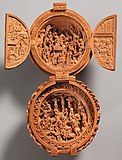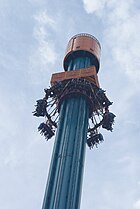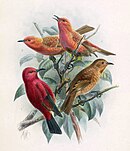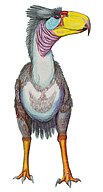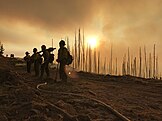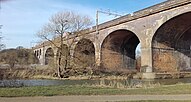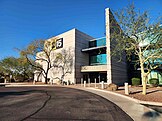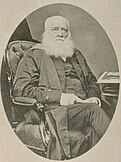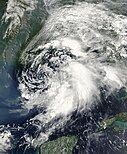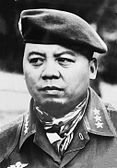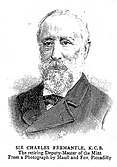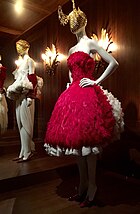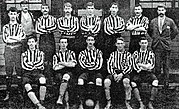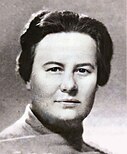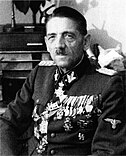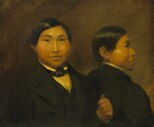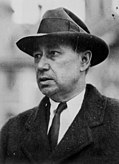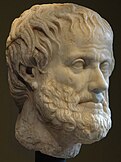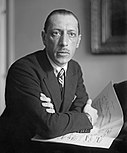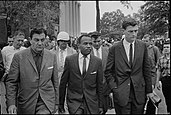Wikipedia:Today's featured article/September 2024
| << | Today's featured articles for September 2024 | >> | ||||
|---|---|---|---|---|---|---|
| Su | Mo | Tu | We | Th | Fr | Sa |
| 1 | 2 | 3 | 4 | 5 | 6 | 7 |
| 8 | 9 | 10 | 11 | 12 | 13 | 14 |
| 15 | 16 | 17 | 18 | 19 | 20 | 21 |
| 22 | 23 | 24 | 25 | 26 | 27 | 28 |
| 29 | 30 | |||||
September 1
Gothic boxwood miniatures are very small Christian-themed wood sculptures produced during the 15th and 16th centuries in the Low Countries, at the end of the Gothic period and during the emerging Northern Renaissance. They consist of highly intricate layers of reliefs made from fine-grained boxwood, often rendered to a nearly microscopic level. Of the approximately 150 surviving examples, the majority are statuettes, skulls, coffins, or spherical beads known as prayer nuts; some 20 are in the form of polyptychs, including triptych and diptych altarpieces, tabernacles, and monstrances. They typically contain imagery from the life of Mary, the crucifixion of Jesus, or vistas of Heaven and Hell. Each miniature required exceptional craftsmanship. Important collections are in the Art Gallery of Ontario, the British Museum, and the Metropolitan Museum of Art in New York. (Full article...)
September 2
Falcon's Fury is a freestanding Sky Jump drop tower attraction at Busch Gardens Tampa Bay, an amusement park in Tampa, Florida. Manufactured by Intaride, a subsidiary of Intamin, the ride is one of North America's tallest freestanding drop towers, with a height of 335 feet (102 m). It was also the first drop tower to use 90-degree tilting seats, facing riders straight down through five seconds of free fall. They reach a speed of 60 miles per hour (100 km/h) before rotating back into a vertical position and decelerating at about 3.5 g. The ride's name is meant to suggest a falcon's ability to dive steeply at high speed to capture prey. Due to the height of the attraction, approval from the Federal Aviation Administration was required. Construction was delayed until 2013, and the opening date was also delayed by mechanical and technical issues. Falcon's Fury opened to park employees in August before a soft opening on August 16, 2014, and an official opening on September 2, 2014. (Full article...)
September 3
The Laysan honeycreeper (Himatione fraithii) is an extinct species of finch, first recorded in 1828, that was endemic to Laysan in the Northwestern Hawaiian Islands. Its length was 13–15 cm (5–6 in) with a 64–69 mm long (2.5–2.7 in) wing. It was bright scarlet vermilion with a faint tint of golden orange on the head, breast and upper abdomen; the rest of its upper parts were orange scarlet. The lower abdomen was dusky gray fading into brownish white. The wings, tail, bill, and legs were dark brown. The bill was slender and downturned. It was nectarivorous and insectivorous, gathering nectar and insects from flowers. The breeding season was probably between January and June, and the clutch size was four or five eggs. In 1903, domestic rabbits were introduced to the island and destroyed its vegetation. In April 1923, only three Laysan honeycreepers were found, one of which was filmed. On April 23, a sandstorm hit the island, and the last birds perished due to lack of cover. (Full article...)
September 4
Battle Birds was an American air-war pulp magazine, published by Popular Publications. It was launched at the end of 1932, but did not sell well, and in 1934 the publisher turned it into an air-war hero pulp titled Dusty Ayres and His Battle Birds. Robert Sidney Bowen, an established pulp writer, provided the lead novel each month, and also wrote the short stories that filled out the issue. Bowen's stories were set in the future, with the United States menaced by an Asian empire called the Black Invaders. The change was not successful enough to be extended beyond the initial plan of a year, and Bowen wrote a novel in which, unusually for pulp fiction, Dusty Ayres finally defeated the invaders, to end the series. The magazine ceased publication with the July/August 1935 issue. It restarted in 1940 under the original title, Battle Birds, and lasted for another four years. All the cover art was painted by Frederick Blakeslee. (Full article...)
September 5
Titanis is a genus of Phorusrhacidae, or "terror birds". The extinct family of large, predatory birds originated in South America and inhabited parts of the present-day United States during the Pliocene. Like all phorusrhacids, Titanis had elongated hind limbs, a thin pelvis, proportionally small wings, and a large skull with a hooked beak. Estimates placed Titanis at 1.4 to 2 meters (4.6 to 6.6 ft) in height and over 300 kilograms (660 lb) in body mass. Phorusrhacids are thought to have been ground predators or scavengers, apex predators that dominated Cenozoic South America. They may have swallowed small prey whole or targeted larger prey with repeated strikes of the beak. Titanis likely preyed on mammals such as the extinct armadillo relatives Holmesina and Glyptotherium, equids, tapirs, capybaras, and other Pliocene herbivores. Titanis is unique among phorusrhacids in that it is the only one known from North America, crossing over from South America during the Great American Interchange. (Full article...)
September 6
The Frye Fire was a wildfire that burned 48,443 acres (19,604 ha) in Graham County, Arizona, United States, from June 7 to September 1, 2017. The fire was ignited by a lightning strike on Mount Graham, within the Coronado National Forest, and spread rapidly until it was mostly contained on July 12. The fire destroyed three buildings and briefly threatened the Mount Graham International Observatory. It cost $26 million (equivalent to $32 million in 2023) to contain and suppress, and involved more than 800 firefighters. There were no fatalities, but 63 firefighters were quarantined with strep throat. During seasonal rains beginning in July, ash and debris from the Frye Fire's burn scar washed off the mountain slopes, then clogged creeks and damaged infrastructure within Graham County. The fire particularly impacted the endangered Mount Graham red squirrel, whose remaining habitat on Mount Graham was devastated. (Full article...)
September 7
Wolverton Viaduct is a railway bridge carrying the West Coast Main Line over the River Great Ouse to the north of Wolverton, part of Milton Keynes, in south-eastern England. Built in 1838 for the London and Birmingham Railway (L&BR) to the design of Robert Stephenson, it was the largest viaduct on the L&BR's route. It is in the centre of Wolverton Embankment, itself the largest on the line. It has six brick arches and covers a distance of 660 feet (200 metres), reaching a maximum height of 57 feet (17 metres) above the river, and terminating in substantial abutments which contain decorative arches. Several contemporary commentators likened Stephenson's bridges to Roman aqueducts. The viaduct was widened to take four tracks in the 1880s with a blue-brick extension, in contrast to the red-brick original. Masts for overhead electrification were added in the 1950s but otherwise the bridge is little changed since it was built and it is now a Grade II listed building. (Full article...)
September 8
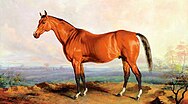
The Jersey Act was a 1913 regulation by the British Jockey Club and the owners of the General Stud Book that prevented most American-bred Thoroughbred horses from registering with them. It was intended to halt the increasing importation of racehorses of possibly impure bloodlines from America. The loss of breeding records during the American Civil War and the late beginning of the registration of American Thoroughbreds led many in the British racing establishment to doubt that American-bred horses were purebred. The Act prohibited the registration of horses unless all of their Thoroughbred ancestors had been registered. Despite protests from American breeders the regulation was in force until 1949. By then, ineligible horses were increasingly successful in races in Europe, British and Irish breeders had lost access to French Thoroughbreds during and after the Second World War, and any impure ancestors of the American bloodlines had receded far back in most horses' ancestry. (Full article...)
September 9
KNXV-TV (channel 15) is a television station affiliated with the ABC network in Phoenix, Arizona, United States, and owned by the E. W. Scripps Company. The station launched on September 9, 1979, as an independent station with evening pay subscription television service from ON TV. It was acquired by Scripps in 1985 and served as Phoenix's first affiliate of the then-new Fox network in 1986, becoming one of its strongest affiliates nationally. A multi-market affiliation realignment caused the station to switch from Fox to ABC between 1994 and 1995, in spite of the latter network's reluctance, as part of a deal between ABC and Scripps. During this time, KNXV-TV launched local newscasts, which met with early success before a downturn in the late 1990s and early 2000s; the news department has since recovered, winning a total of three George Foster Peabody Awards. In 2019, Scripps acquired a second Phoenix station, KASW. (Full article...)
September 10
Ken "Snakehips" Johnson (10 September 1914 – 8 March 1941) was a swing band leader and leading figure in black British music of the 1930s and 1940s. Born in British Guiana, he was educated in Britain and travelled to New York to immerse himself in the Harlem jazz scene. He returned to Britain and established the Aristocrats (or Emperors) of Jazz, a mainly black swing band, with Leslie Thompson. In 1937 Johnson took control of the band through a legal loophole, causing the departure of Thompson and several musicians. Johnson filled the vacancies with Caribbean musicians, the band's popularity grew, and it changed its name to the West Indian Dance Orchestra. In 1938 the band broadcast on BBC Radio, recorded their first discs and appeared in an early television broadcast. Johnson was considered a pioneer for black musical leaders in the UK. While the band was employed as the house band at the Café de Paris, a German bombing raid in 1941 hit the nightclub, killing Johnson. (Full article...)
September 11
John Rolph (1793–1870) was a physician, lawyer, and political figure. He immigrated to Upper Canada in 1813 and practised law and medicine concurrently. In 1824, Rolph was elected to the Parliament of Upper Canada. He was elected as an alderman to Toronto's first city council but resigned after his council colleagues did not select him as the city's mayor. When the Upper Canada Rebellion began in 1837, Rolph did not join the rebels even though he agreed to support them. Instead, the Lieutenant Governor appointed him as his emissary to deliver the government's truce offer. After the rebellion, Rolph fled to the US and focused on his medical career. The Canadian government granted him amnesty and he returned to Canada in 1843, later creating a new medical institution in Toronto called the Rolph School. In 1851 he was elected to the Legislative Assembly of the Province of Canada, but resigned three years later. He retired in 1870 and died later that year. (Full article...)
September 12
Tropical Storm Hanna was the ninth tropical cyclone and eighth named storm of the 2002 Atlantic hurricane season. Hanna formed through the complex interaction of a surface trough, a tropical wave, and an upper-level low pressure system. Initially designated a tropical depression, it attained tropical storm status and a peak intensity of 1,001 mbar (29.6 inHg), with winds of 60 miles per hour (100 km/h). Hanna crossed southeastern Louisiana, and made a second landfall along the Alabama–Mississippi border. On Dauphin Island, Alabama, the storm caused coastal flooding which closed roads and forced the evacuation of residents. Florida received high wind gusts, heavy rainfall, and strong surf that resulted in the deaths of three swimmers. 20,000 homes in the state lost electricity. In Georgia, significant flooding occurred. Crop damage was extensive, and about 335 structures were damaged by the flooding. The storm caused a total of about $20 million USD in damage. (Full article...)
September 13
An attempted coup took place on September 13, 1964, in South Vietnam against the ruling military junta led by Nguyễn Khánh (pictured). In the preceding month, Khánh had tried to augment his power by declaring a state of emergency, provoking protests and riots. He made concessions to the protesters and removed military officials linked to former President Ngo Dinh Diem, including Lâm Văn Phát and Dương Văn Đức. They responded with a coup, broadcasting their promise to revive Diem's policies. Khánh evaded capture and rallied allies while the U.S. continued their support for his rule. Khánh forced Phát and Đức to capitulate the next morning and various coup leaders appeared at a media conference where they denied that a coup had taken place. To maintain power, Khánh tried to court support from Buddhist activists, who supported negotiations to end the Vietnam War. As the Americans were strongly opposed to such policies, relations with Khánh became strained. (Full article...)
September 14
Sir Charles William Fremantle (1834–1914) was a British official who served for 26 years as deputy master of the Royal Mint, and for most of that time as its executive head. Educated at Eton College, he served as private secretary to several officials, latterly Benjamin Disraeli, including while Disraeli was prime minister in 1868. Disraeli appointed him as deputy to Thomas Graham, the master of the Mint. Graham died in September 1869, and the Treasury decided the mastership should go to the chancellor of the exchequer of the day, with the deputy master the head of the Royal Mint. Fremantle began work to modernise the antiquated Royal Mint. Fremantle sought to beautify the coinage and, believing the Mint's engraver, Leonard Charles Wyon, not up to the task, sought to do so by resurrecting classic coin designs, like Benedetto Pistrucci's depiction of Saint George and the Dragon for the sovereign. In 1894, at the age of sixty, Fremantle retired from the Royal Mint. (Full article...)
September 15
Al-Mustaʿlī biʾllāh (15/16 September 1074 – 1101) was the ninth Fatimid caliph and the nineteenth imam of Musta'li Ismailism. He became caliph through the machinations of his brother-in-law al-Afdal Shahanshah. In response, his oldest brother, Nizar, revolted in Alexandria; his defeat and execution split the Isma'ili movement. Al-Musta'li remained subordinate to al-Afdal, who was the de facto ruler of the Fatimid Caliphate. The Caliphate's territory in Egypt experienced good government and prosperity, but the Fatimids suffered setbacks in Syria, where they faced the advance of the Seljuk Turks. Al-Afdal recovered the port city of Tyre and recaptured Jerusalem in the turmoil caused by the arrival of the First Crusade. Despite Fatimid attempts to make common cause with the Crusaders against the Seljuks, the Crusaders advanced south and captured Jerusalem in July 1099 and defeated the Fatimid army at the Battle of Ascalon. Al-Musta'li died in 1101 and was succeeded by his son al-Amir. (Full article...)
September 16
Jeremy Thorpe (1929–2014) was a British politician who served as Member of Parliament for North Devon from 1959 to 1979, and as leader of the Liberal Party between 1967 and 1976. After graduating from Oxford University, he became one of the Liberals' brightest stars in the 1950s. Thorpe capitalised on the growing unpopularity of the Conservative and Labour parties to lead the Liberals through a period of electoral success. This culminated in the general election of February 1974, when the party won 6 million votes. In May 1979 he was tried at the Old Bailey on charges of conspiracy and incitement to murder, arising from an earlier relationship with Norman Scott, a former model. Thorpe was acquitted on all charges, but the case, and the scandal, ended his political career. By the time of his death he was honoured for his record as an internationalist, a supporter of human rights, and an opponent of apartheid and all forms of racism. (Full article...)
September 17
Sir Frederick "Boy" Browning (1896–1965) was a British Army general who has been called the "father of the British airborne forces". He was also an Olympic bobsleigh competitor, and the husband of author Daphne du Maurier. Educated at Eton College and the Royal Military College, Sandhurst, he was commissioned into the Grenadier Guards in 1915 and served on the Western Front in the First World War. During the Second World War, Browning commanded the I Airborne Corps in Operation Market Garden in September 1944. During the planning for this operation, he was alleged to have said: "I think we might be going a bridge too far." In December 1944 he became chief of staff of Admiral Lord Mountbatten's South East Asia Command. After the war Browning was comptroller and treasurer to Princess Elizabeth, Duchess of Edinburgh. After she ascended to the throne as Queen Elizabeth II in 1952, Browning became treasurer in the Office of the Duke of Edinburgh. (Full article...)
September 18
The Girl Who Lived in the Tree is the 32nd collection by British fashion designer Alexander McQueen, made for the Autumn/Winter 2008 season. The primary inspirations were British culture and national symbols, particularly the British monarchy, as well as the clothing of India during the British Raj. It was presented through the narrative of a fairy tale about a feral girl who lived in a tree before falling in love with a prince and descending to become a princess. The collection's runway show was staged on 29 February 2008 at the Palais Omnisports de Paris-Bercy in Paris. Forty-two looks were featured in two phases: during the first the ensembles were all in black and white, with most having a slim, tailored silhouette; those from the second were richly coloured, with luxurious materials and embellishments (examples pictured). Critical response was positive, and in retrospect it is regarded as one of McQueen's best collections. Garments from the collection are held by various museums. (Full article...)
September 19
During their 1894–95 season, New Brompton F.C. (known as Gillingham F.C. since 1912) competed in the Southern Football League Division Two. The club had been formed a year earlier but in the inaugural season played only friendly matches and games in the qualifying rounds of the FA Cup and FA Amateur Cup. In 1894, New Brompton turned professional and joined the newly formed Southern League. The team dominated Division Two of the new league, winning all but one of their matches, and gained promotion to Division One by winning an end-of-season "test match" against Swindon Town, who had finished bottom of the higher division. New Brompton also entered the FA Cup, reaching the third qualifying round. The team played 15 competitive matches, winning 13, drawing none, and losing two. Arthur Rule was the team's top goalscorer for the season. The highest attendance recorded at the club's home, the Athletic Ground, was approximately 8,000 for the visit of Chatham in the FA Cup. (Full article...)
September 20
Addie Viola Smith (1893–1975) was an American attorney who served as the U.S. trade commissioner to Shanghai from 1928 to 1939, the first female Foreign Service officer in the U.S. Foreign Service to work under the Commerce Department, and the first woman to serve as trade commissioner. A native of Stockton, California, Smith moved to Washington, D.C., in 1917. While working for the United States Department of Labor, she attended the Washington College of Law part-time, earning a Bachelor of Laws degree in 1920. She joined the Foreign Service in October that year. Posted to Beijing as a clerk, she was promoted to assistant trade commissioner in Shanghai in 1922, and to trade commissioner in 1928. She later held roles in the U.S. government, world organizations, and the United Nations. Smith met her life partner, Eleanor Mary Hinder, in 1926; they moved to Hinder's native Australia in 1957, where stone seats are dedicated to them at the E. G. Waterhouse National Camellia Gardens. (Full article...)
September 21
Artur Phleps (29 November 1881 – 21 September 1944) was an Austro-Hungarian, Romanian and Nazi officer who was an SS-Obergruppenführer und General der Waffen-SS in the Waffen-SS during World War II. He was an Austro-Hungarian Army officer before and during World War I. During the interwar period, he joined the Romanian Army and became an adviser to King Carol. After he spoke out against the government, he was made to leave the army. In 1941 he joined the Waffen-SS. He saw action on the Eastern Front before raising two Waffen-SS mountain divisions and one corps in occupied Yugoslavia. Units under his command committed many crimes against the civilian population of the Independent State of Croatia. This became controversial when his onetime translator, Kurt Waldheim, successfully ran for the Austrian presidency in the 1980s. In addition to the Knight's Cross of the Iron Cross, Phleps was awarded the German Cross in Gold, and, posthumously, was awarded the Oak Leaves to his Knight's Cross. (Full article...)
September 22
Qalaherriaq (c. 1834 – 1856) was an Inughuit hunter from Cape York in northwestern Greenland. Born around 1834 and baptized Erasmus Augustine Kallihirua, he was taken aboard the British barque HMS Assistance in 1850 as an interpreter during the search for Franklin's lost expedition. He guided the ship to Wolstenholme Fjord to investigate rumors of a massacre of Franklin's crew, but found the corpses of local Inughuit and crew from an unrelated British vessel. Poor sea conditions prevented the Assistance from returning to Qalaherriaq's family, and he was instead taken to England and placed in the custody of the Society for Promoting Christian Knowledge. He was enrolled in St Augustine's College at Canterbury and studied English and Christianity. In 1855, he was tasked by Edward Feild, Bishop of Newfoundland, to join him on a mission to the Labrador Inuit. Qalaherriaq's health problems, which he had developed during his service as an interpreter, worsened after his arrival in Newfoundland, and he died at St. John's in 1856 around 22 years old. (Full article...)
September 23
Arthur Oswin Austin (1879–1964) was an American electrical engineer and inventor. He is best known as the inventor of the Austin transformer, used to supply power for lighting circuits on radio towers. Austin's work included improvements to radio transmission equipment and the effects of lightning on high-voltage transmission lines and aircraft. He was a fellow of the American Institute of Electrical Engineers and of the Institute of Radio Engineers, and was known as an expert in high-voltage insulators and fittings. His work on transmitting antennas included both military and civilian projects. Born in California, Austin graduated from Stanford University with a degree in electrical engineering. He spent most of his adult life in Ohio where he worked for the Ohio Brass Company and founded the Austin Insulator Company. He bought a large estate in Barberton, Ohio, lived in the mansion, and built an extensive outdoor electrical laboratory on the grounds. (Full article...)
September 24

Pinkerton is the second studio album by the American rock band Weezer, released on September 24, 1996, by DGC Records. To better capture their live sound, the band self-produced Pinkerton, creating a darker, more abrasive album than their 1994 debut Weezer. The lyrics express loneliness and disillusionment with the rock lifestyle, and reference Japanese culture. Pinkerton produced the singles "El Scorcho" and "The Good Life". It debuted at number 19 on the Billboard 200, failing to match sales of Weezer's debut, and received mixed reviews; Rolling Stone readers voted it the third-worst album of 1996. For subsequent albums, Weezer returned to more traditional pop songwriting and less personal lyrics. In subsequent years, Pinkerton was reassessed; several publications named it one of the best albums of the 1990s, and it was certified platinum in 2016. (Full article...)
September 25
SMS Helgoland was a dreadnought battleship of the Imperial German Navy. Her design improved from the Nassau class, including an increase in the bore diameter of the main guns. Her keel was laid down at the Howaldtswerke shipyards in Kiel; she was launched on 25 September 1909, and commissioned on 23 August 1911. During World War I the ship participated in several sweeps into the North Sea as the covering force for the battlecruisers of the I Scouting Group. She saw limited duty in the Baltic Sea against the Russian Navy, including serving as part of a support force during the Battle of the Gulf of Riga in August 1915. Helgoland was present at the Battle of Jutland from 31 May to 1 June 1916, though she was located in the center of the German line of battle and not as heavily engaged as the ships in the lead. She was ceded to Great Britain after the war and broken up for scrap in the early 1920s. Her coat of arms is preserved in the Bundeswehr Military History Museum in Dresden. (Full article...)
September 26
The 2023 World Snooker Championship took place from 15 April to 1 May 2023 at the Crucible Theatre (pictured) in Sheffield, England. The qualifying rounds produced a 115 break by Ng On-yee, the highest by a woman in the tournament's history. The defending champion Ronnie O'Sullivan made a record 31st appearance at the tournament's main stage, surpassing the 30 appearances by Steve Davis, but he lost 10–13 in the quarter-finals to Belgian player Luca Brecel. Si Jiahui became the first Crucible debutant to reach the semi-finals since Andy Hicks at the 1995 event. Brecel came from 5–14 behind to defeat Si 17–15, the first player to win a match at the Crucible after trailing by nine frames. Brecel went on to defeat Mark Selby 18–15 in the final, becoming the sport's first world champion from mainland Europe. Two maximum breaks were made at the main stage, one by Kyren Wilson in the first round and the other by Selby, who became the first player to make a 147 in a world final. (Full article...)
September 27
Ethics is the philosophical study of moral phenomena, or what people ought to do. It includes three main branches: normative ethics, which seeks general principles for how people should act; applied ethics, which addresses specific real-life ethical issues like abortion; and metaethics, which explores underlying concepts and assumptions. Influential normative theories are consequentialism, deontology, and virtue ethics. According to consequentialists, an act is right if it leads to the best consequences. Deontologists focus on acts themselves, saying that they must adhere to duties, like telling the truth. Virtue ethicists, such as Aristotle (pictured), see the manifestation of virtues, like courage, as the fundamental principle of morality. The history of ethics dates back to ancient civilizations and has evolved through religious influences in the medieval period to a more secular approach in the modern era, with the emergence of metaethics in the 20th century. (Full article...)
September 28
Igor Stravinsky (1882–1971) was a Russian composer and conductor, considered one of the most important and influential composers of the 20th century and a pivotal figure in modernist music. He studied music under Nikolai Rimsky-Korsakov until the latter's death in 1908. Soon after, Stravinsky met the impresario Sergei Diaghilev, who commissioned the composer to write three ballets for the Ballets Russes's Paris seasons: The Firebird (1910), Petrushka (1911), and The Rite of Spring (1913), the last of which caused a near-riot at the premiere due to its avant-garde nature. His compositional style varied greatly, being influenced at different points by Russian folklore, neoclassicism, and serialism. His ideas influenced the composers Aaron Copland, Philip Glass, Béla Bartók, and Pierre Boulez, who were all challenged to innovate beyond traditional tonality, rhythm, and form. Stravinsky died in 1971, leaving six memoirs, an earlier autobiography, and a series of lectures. (Full article...)
September 29
The Aston Martin Lagonda Taraf is a full-size luxury car with four doors that was manufactured in 2015 and 2016 by the British carmaker Aston Martin under its Lagonda marque. Aston Martin began developing the car in February 2014 at its design studio in Gaydon, Warwickshire. Development was completed eight months later, and the design of the car, based on the vertical–horizontal platform, was done by Marek Reichman. The car debuted in Dubai in December 2014, and production began in early 2015 at the Gaydon production facility. Initially, Aston Martin planned to manufacture 100 units exclusively for the Middle Eastern market, but the plan expanded to include other markets and a total of 120 cars were produced. The Taraf features an aluminium structure and a carbon-fibre exterior, giving it a weight comparable to the significantly shorter Aston Martin Rapide. Manufacture of the Taraf ceased at the end of 2016. (Full article...)
September 30
The Ole Miss riot of 1962 was a violent disturbance at the University of Mississippi (commonly called Ole Miss) in Oxford, Mississippi, as segregationist rioters sought to prevent the enrollment of James Meredith, an African-American. In the wake of the Supreme Court's 1954 decision Brown v. Board of Education, Meredith applied to Ole Miss in 1961. His admission was delayed and obstructed, including by Mississippi governor Ross Barnett, who even had him temporarily jailed. Meredith's multiple attempts to enroll, accompanied by federal officials, were physically blocked. A riot erupted on campus when a mob assaulted reporters and federal officers, burned and looted property, and hijacked vehicles. Two civilians were murdered and 160 marshals were injured, including 28 who received gunshot wounds. U.S. President John F. Kennedy invoked the Insurrection Act of 1807 and mobilized more than 30,000 troops, quelling the riot. A statue of Meredith on campus commemorates the event. (Full article...)

